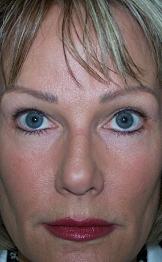Move cursor over buttons on the left

About Permanent Makeup
Permanent Cosmetic Makeup is the process of applying micro insertions of natural pigments to the dermal layer of the skin, also known as micropigmentation. The procedures are performed by a qualified artist. The resultant quality depends upon both the skill of the practioner and the specific technique employed. When applied properly, the procedure is completely safe and with minimal discomfort.
Permanent makeup allows individuals to always look their best, even with busy lifestyles. It is used by women and men of every age and race to improve appearance. Permanent makeup does not smear so it is ideal for persons with oily skin. People who wear contacts also enjoy permanent makeup because it does not flake. Often persons suffering from allergic reactions have permanent makeup because it replaces cosmetic products they cannot tolerate. A range of colors and application methods are available to the client. A bold dramatic look can be created or, though conservative application, a natural look that never goes out of style can be achieved.
Lips
The Permanent Makeup procedure for lip stick can appear as if to change the size and shape of the lips as well as the color. This procedure helps to prevent lipstick from bleeding into the surrounding skin. It can also camouflage facial lines surrounding the lips as a result of aging. A soft pinkish/red is popular for those wanting a natural look, while a more dramatic look can be achieved by darker reds.
Lips II
As indicated in the example, the highlighting provided by permanent makeup can emphasize the natural sensuous curves of the lips.
Eyebrows
A Permanent Makeup procedure can mimic the appearance of hair in the brow line. Anyone who desires more fullness of the brows, especially those who use a pencil will appreciate the procedure, enabling them to swim, play tennis, or wipe their forehead without embarrassment of no eyebrows.
Upper and Lower Liner
Application of eye liner adds an enhanced "permanent" brightness to eyes.
A subtle natural look, mimicking thousands of tiny eyelashes is achieved by implanting pigments in the lash line. Additional shadowing of color can create a "smudged" look or a more bold definite line. Opthalmologists recommend these procedures for those who are allergic to conventional makeup and for those wearing contact lenses.
Before
Intermediate
After
Reconstruction & Areola
A range of pink-brown color is applied to the areola to create the appearance of changing the size or shape. Cancer patients undergoing breast reconstruction particularly benefit from this application of permanent makeup.
Camouflage
Micropigmentation is successful in pigmenting regions of hair loss, scars, and burns. Until recently, clients with scars or burns have had to rely on the daily application of makeup to disguise imperfections. Micropigmentation can help restore natural skin tones. Since slight fading sometimes occurs, touch-ups can easily be done at a later time.
Hypopigmentation
Pigment production and distribution in the body may be affected by heredity, heat, trauma, sun exposure, diet, and other factors. Changes in any of these factors can result in hypopigmentation (decrease in pigment production). Hypopigmentation may be camouflaged by permanent makeup to yield an appearance closely matching the adjacent skin tones.
On the left is an example of hypopigmentation before and after micropigmentation.















